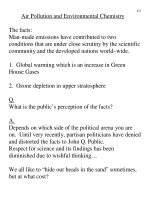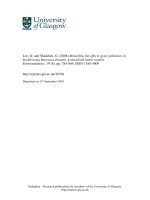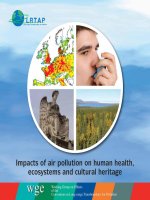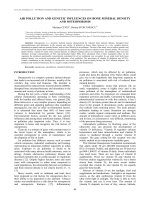Air pollution impacts on birds and insects pdf
Bạn đang xem bản rút gọn của tài liệu. Xem và tải ngay bản đầy đủ của tài liệu tại đây (254.77 KB, 7 trang )
Air pollution impacts on
birds and insects
Project leader: Tapio Eeva, docent
Ph.D. students: Jouni Sorvari, Saila Sillanpää
;
M.Sc.
student: Ville Vähä-Iitu
Collaborators: Mikko Nikinmaa (Univ. Turku),
Marcel Eens (Univ. Antwerp), Markus Rantala
(Univ. California), Juha-Pekka Salminen (Univ.
Turku), Eugen Belskii (Russian Acad. Sci)
Background
Effects of air pollution on the Pied Flycatcher(
Ficedula hypoleuca
) and the Great Tit (
Parus major
)has
been studied in the surroundings of a copper smelter of Harjavalta (SW Finland) since 1991. Our aim
has been to find out how atmospheric emissions of heavy metals (especially copper, nickel and lead)
and acidic substances affect the breeding success and survival of birds.
The main results
One of the main interests in our project has been whether the detrimental effects are direct toxic effects
or indirect effects (e.g. due to decreased amount of food). We have found both. The two bird species
respond differently to pollution. The pied flycatcher suffers from poor quality egg shells
and growth
abnormalities of nestlings, but these effects are restricted only to relatively small area (1 - 2 km) around
the factory complex. The great tit suffers most in late nestling stage, when the growth of nestling is
retarded and mortality increased.
In summary, the pied flycatcher seems to suffer more from the direct toxic effects whereas the great tit
suffers more from the reduced amount of suitable food for nestlin
g
s.
Background The main results Future work The latest results Media Publications
Great tits in the polluted area are fading
We have found that the air pollution can cause changes in the plumage colour of great tits. The breast
feathers of the great tit are normally yellow, but the yellow plumage of young great tits is significantly
paler the closer to the pollution source they live (Functional Ecology 12: 607-612). Read articles: The
Economist, Priroda [Nature, Moscow] (In Russian) and Helsingin Sanomat (In Finnish).
The pigments responsible for colouring feathers yellow are derived from chemicals called carotenoids.
Birds cannot make these chemicals themselves and so must obtain them indirectly through what they
eat.
The problem is that pollutants emitted from the smelting plant are causing a decrease in the number of
green caterpillars
, an important component of the great tit diet generally and a vital source of
carotenoids. The plumage colour study will continue next summer.
Future work
Birds’ defence mechanisms against environmental stress can be behavioural, physiological or
biochemical. Often, they are related to the quality of birds’ diet. For example, recent studies have
revealed the importance of dietary carotenoids on the immunocompetence of birds. An analogous, but
less studied, is the role of carotenoids (i.e. antioxidants) in defence against
toxic substances
(heavy
metals, PCBs, PAHs and brominated flame retardants). In our future study we want to examine how
these defence mechanisms are dependent on the diet of wild bird populations. The main issues in our
study area:
z
Food quality and defence mechanisms
z
Does air pollution cause genetic changes?
z
Interspecific differences in defence ability
Birds' diet is studied by collecting food samples and by following nestling feeding with video cameras
attached into nest-box roof. Look yourself how a pied flycatcher male brings a green caterpillar and a
cockroach to nestlings and takes a faecal sac away.
Video (wmv), 1.8 mb
The most recent results
Breeding success was improved after decreased emissions
Breeding success of the great tit and pied flycatcher has markedly improved in the vicinity of the
copper smelter during 1991 - 1997, when heavy metal emissions
markedly decreased. Lead
concentrations in nestling bones tissues were decreased about 90% and the number of fledglings
increased by about 1.6 chicks in both species. The results suggest that even in an area with decades
long heavy metal pollution history, positive results of reduced pollution loads on wild bird populations
can be observed over a relatively short time period. (Nature 403: 851-852)
Birds did not show reduced immunocompetence in the polluted area
We investigated whether heavy metal pollution changed the immunocompetence of the pied flycatcher.
We measured humoral and T-cell mediated immune responses in two study areas: a polluted area in the
vicinity of a copper smelter and a control area far from the smelter. The immunocompetence of
F.
hypoleuca
was not suppressed by pollution stress. In contrast, we found that
F. hypoleuca
males
showed stronger humoral immune responses to a novel antigen (tetanus toxoid) in the polluted
environment than in the unpolluted one. No significant pollution-related effects were found in humoral
immune response of females or T-cell mediated immune response of nestlings, despite the lower
fled
g
in
g
success in the
p
olluted area. Our results su
gg
est that humoral immune res
p
onse of birds ma
y
News!
actually be enhanced, or hyper-activated, under moderate levels of heavy metal pollution. This may
cause some extra costs for birds during breeding.
Our study and media
Newspaper and magazine articles on bird study in Harjavalta:
Talitiaiset tarkkailussa Harjavallan seudulla - Satakunnan Kansa 1991
Kirjosieppo ja talitiainen kärsivät ilmansaasteista - Turun Sanomat 1996
Kirjosieppo ja talitiainen kärsivät ilmansaasteista eri tavoin - Lapin Kansa 1996
Ilmansaasteiden vaikutukset väitöskirjan aiheina - Vakka-Suomen Sanomat 1996
Fading signals - The Economist 1998
Ilmansaasteet haalistavat talitiaisen rintahöyhenet - Helsingin Sanomat 1998
Kirjosieppo kärsii ilman saasteista - Maaseudun Tulevaisuus 1998
Smog casts a pall over sex life of birds - New Scientist 1998
Great tits in polluted area are fading fast - BBC Wildlife Magazine 1999
Feedback - New Scientist 1999
Great Tit is Voting for Clean Air - Priroda [Nature, Moscow] 1999
Kirjosieppo riutuu Harjavallan tehtaan varjossa - Helsingin Sanomat 1999
Artikkeli Harjavallan lintututkimuksista - Keski-Pohjanmaa 1999
Koikkalaisen pakina - Seura 1999
Tehtaiden naapurissa asustaa kalvakkaita talitinttejä - Kemia 26/99
Linnut kertovat ympäristön muutoksista - TV-2, EKOISTI 1999
Pollution’s True Colours - Nature Australia 2000
Linnusto toipuu luonnon puhdistuessa - Turun Sanomat 2000
Flying comeback - New Scientist 2000
Komea isä saa poikia - Satakunnan Kansa 2000
Enemmän poikasia, vähemmän raajarikkoja - Helsingin Sanomat 2000
Links
Ilmansuojelu (2/98):Effects of heavy metal emissions in forests around Harjavalta
Publications
, reprint requests to Tapio Eeva
Eeva, T., Lehikoinen, E. and Nurmi, J. 1994: Effects of ectoparasites on breeding success of great tit
(
Parus major
) and pied flycatcher (
Ficedula hypoleuca
) in an air pollution gradient. -
Canadian
Journal of Zoology
72: 624-635. Abstract (PDF)
Eeva, T., & Lehikoinen, E. 1994: Effects of Air Pollution on the Breeding of Pied Flycatcher
Ficedula
hypoleuca
and Great Tit
Parus major
. -
Journal für Ornithologie
135: 236 (Abstract).
Eeva, T. & Lehikoinen, E. 1995: Egg shell quality, clutch size and hatching success of the great tit
(
Parus major
) and the pied flycatcher (
Ficedula hypoleuca
) in an air pollution gradient. -
Oecologia
102: 312-323. Abstract
(
)
Eeva, T. & Lehikoinen, E. 1996: Growth and mortality of nestling great tits (
Parus major
) and pied
flycatchers (
Ficedula hypoleuca
) in a heavy metal pollution gradient. -
Oecologia
108: 631-639.
Abstract (PDF)
Eeva, T. 1996: Direct and indirect effects of air pollution on two hole-nesting bird species. -
Annales
Universitatis Turkuensis
Ser. A. Tom. 83 (doctoral dissertation).
Eeva, T. & Lehikoinen, E. 1997: Talitiainen ja kirjosieppo kärsivät eri tavoin ilmansaasteista. -
Luonnon Tutkija
3: 79-82.
Eeva, T., Lehikoinen, E. & Pohjalainen, T. 1997: Pollution-related variation in food supply and
breeding success in two hole-nestong passerines. -
Ecology
78: 1120-1131. Full text (PDF)
Eeva, T., Lehikoinen, E. & Sunell C. 1997: The quality of pied flycatcher (
Ficedula hypoleuca
) and
great tit (
Parus major
) females in an air pollution gradient. -
Annales Zoologici Fennici
34: 61-71.
Full text (PDF)
Eeva, T. & Lehikoinen, E. 1998: Local survival rates of the pied flycatchers (
Ficedula hypoleuca
) and
the great tits (
Parus major
) in an air pollution gradient. -
Ecoscience
5: 46-50.
Eeva, T., Lehikoinen, E. & Rönkä, M. 1998: Air pollution fades the plumage of the great tit. -
Functional Ecology
12: 607-612. Full text (PDF)
Lehtiniemi, T. 1998: Kirjosiepon värimuodoista. -
M.Sc. Thesis
. University of Turku. 56 pp.
Sarholm, E. 1998: Talitiaisen (
Parus major
) ja kirjosiepon (
Ficedula hypoleuca
) ravinto ja
ruokailukäyttäytyminen tunnetussa ilmansaastegradientissa. -
M.Sc. Thesis
. University of Turku. 42
pp.
Bojarinova, J. G., Lehikoinen, E. & Eeva, T. 1999: Dependence of postjuvenile moult on hatching
date, condition and sex in the Great Tit. -
Journal of Avian Biology
30: 437-446. Full text (PDF)
Tanhuanpää, S., Eeva, T., Lehikoinen, E. & Nikinmaa, M. 1999: Developmental changes in 7-
ethoxyresorufin-O-deethylase (EROD) and -aminolevulinic acid dehydratase (ALA-D) activities in
three passerines. -
Comparative Biochemistry and Physiology
: Part C 124: 197-202. Full text (PDF)
Eeva, T., Ojanen, M., Räsänen, O. & Lehikoinen, E. 2000: Empty nests in the great tit (
Parus major
)
and the pied flycatcher (
Ficedula hypoleuca
) in a polluted area. -
Environmental pollution
109: 303-
309. Full text (PDF)
Lehikoinen, E. 1999: Talitiaisen puku haalistuu Harjavallassa. -
Aurora
3: 16-17.
Lehikoinen, E., Eeva, T. & Rönkä, M. 1999: Harjavallan pönttölinnut ilman saastumisen vaikutuksen
mittareina. -
Linnut
3: 12-16.
Lehikoinen, E. (1999): Ilmansaasteet haalistuttavat talitiaiset. -
Suomen Luonto
2/99: 18.
Rönkä, M. 1999: Talitiaisen (
Parus major
) poikasten höyhenpuvun väritys ilmansaastegradientilla. -
M.Sc. Thesis
. University of Turku. 76 pp.
Eeva, T., Tanhuanpää, S., Råbergh, C., Airaksinen, S., Nikinmaa, M. & Lehikoinen E. 2000:
Biomarkers and fluctuatin
g
as
y
mmetr
y
as indicators of
p
ollution induced stress in two hole-nestin
g
passerines. -
Functional Ecology
14: 235-243. Full text (PDF)
Eeva, T. & Lehikoinen, E. (2000): Pollution and breeding success in wild birds. -
Nature
403: 851-852.
Full text (PDF)
Lehikoinen, E. & Eeva, T. (2000): Tunne tuttu talvilintu. -
Tiede 2000
2/2000.
Ilmonen, P., Taarna, T. & Hasselquist, D. (2000): Experimentally activated immune defence in female
pied flycatchers results in reduced breeding success. -
Proceedings of the Royal Society of London
B
267: 1-6. Full text (PDF)
Taarna, T. 2000: Haudonnan kustannukset ja taudinvastustuskyky kirjosiepolla (
Ficedula hypoleuca
). -
M.Sc. Thesis
. University of Turku. 50 pp.
Viljanen, M. 2000: Kirjosiepon (
Ficedula hypoleuca
) lisääntymismenestys erilaisissa
elinympäristöissä. -
M.Sc. Thesis
. University of Turku. 31 pp.
Eeva, T., Lehikoinen, E., Rönkä, M., Lummaa, V. & Currie, D. (2002): Different responses to cold
weather in two pied flycatcher populations. -
Ecography
25: 705-713. Full text (PDF)
Eeva, T., Hakkarainen, H. & Koivunen, V. (2003): Population densities of forest birds in a heavy metal
pollution gradient.
- Avian Science
2: 227-236. Full text (PDF)
Ryömä, M. (2003): Ravinnon laadun vaikutus talitiaisen (
Parus major
) ja kirjosiepon (
Ficedula
hypoleuca
) poikasten raskasmetallialtistukseen. -
M.Sc. Thesis
. University of Turku. 54 pp.
Eeva, T., Lehikoinen, E. and Nikinmaa, M. (2003): Pollution-induced nutritional stress in nestling
birds: an experimental study of direct and indirect effects. -
Ecological Applications
13: 1242-1249.
Full text (PDF)
Eeva, T. & Lehikoinen, E. (2004): Rich calcium availability diminishes heavy metal toxicity in Pied
flycatcher. –
Functional Ecology
18: 548-553. Full text (PDF)
Ahola, M., Laaksonen, T., Sippola, K., Eeva, T., Rainio, K. and Lehikoinen, E. 2004 Variation in
climate warming along the migration route uncouples arrival and breeding dates. –
Global Change
Biology
10: 1610-1617. Full text (PDF)
Eeva, T., Sorvari, J. & Koivunen, V. (2004): Effects of heavy metal pollution on red wood ant
(
Formica
s.str.) populations
.
–
Environmental Pollution
132: 533-539. Full text (PDF)
Both, C., Artemyev, A. V., Blaauw, B., Cowie, R. J., Dekhuijzen, A. J., Eeva, T., Enemar, A.,
Gustafsson, L., Ivankina, E. V., Jarvinen, A., Metcalfe, N. B., Nyholm, N. E. I., Potti, J., Ravussin, P.
A., Sanz, J. J., Silverin, B., Slater, F. M., Sokolov, L. V., Torok, J., Winkel, W., Wright, J., Zang, H.
and Visser, M. E. 2004 Large-scale geographical variation confirms that climate change causes birds to
lay earlier. –
Proceedings of the Royal Society of London Series B - Biological Sciences
271: 1657-
1662. Full text (PDF)
Eeva, T., Hasselquist, D., Langefors, Å., Tummeleht, L., Nikinmaa, M. and Ilmonen, P. (2005):
Pollution related effects on immune function and stress in a free-living population of pied flycatcher. –
Journal of Avian Biology
36: 1-8. Full text (PDF)
Nikkinen, L.
(
2005
)
: The effect of carotenoids on
p
luma
g
e colour and success of
g
reat tit
(
Parus
major
) in a polluted environment. –
M.Sc. Thesis
. University of Turku. 53 pp. (
In Finnish
) Full text
(PDF)
Eeva, T., Ryömä, M. and Riihimäki, J. 2005. Pollution-related changes in diets of two insectivorous
passerines. –
Oecologia
145: 629-639. Full text (PDF)
Eeva, T., Belskii, E. & Kuranov, B. (2006): Environmental pollution affects genetic diversity in wild
bird populations.
– Mutation Research
608: 8 - 15. Full text (PDF).
Eeva, T., Hakkarainen, H., Laaksonen, T. & Lehikoinen, E. (2006): Environmental pollution has sex-
dependent effects on local survival. B
Biology Letters
2: 298-300. Full text (PDF)
Laaksonen, T., Ahola, M., Eeva, T., Väisänen, R. and Lehikoinen, E. (2006) Climate change, migratory
connectivity and changes in laying date and clutch size of the Pied flycatcher. B
Oikos
(
In
press
).
Sorvari, J., Rantala, L.M., Rantala, M.J., Hakkarainen, H. and Eeva T. (2006): Heavy metal pollution
disturbs immunity: toxic effects in wild ant populations. B
Environmental Pollution
(
In
press
). Full text (PDF)
| Section of Ecology | Department of Biology |
| University of Turku |









